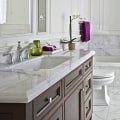Designing a bathroom is one of the most rewarding parts of my job as an interior designer. To help you create a functional and aesthetically pleasing bathroom, I'll provide 16 general rules for bathroom space planning. From the minimum distance between accessories to the optimal headroom, these guidelines will help you create a bathroom that meets all building codes and design recommendations. Local building codes often say nothing about the recommended optimal spacing of toilets, sinks, tubs and showers.
Instead, groups in the home improvement industry, such as the non-profit National Kitchen and Bath Association (NKBA), come up with recommendations that many bathroom and kitchen designers use when designing rooms. The NKBA recommends a minimum of 21 inches from the front edge of all accessories (sink, toilet, bidet, bathtub, and shower) to any bathroom accessory, wall, or opposing obstacle. However, even NKBA guidelines should be considered as minimal. If you have extra space, you should consider increasing the NKBA guidelines by several centimeters.When it comes to toilets, consider that the 21-inch minimum recommended by the NKBA is the absolute minimum.
With the popularity of longer-bowl residential toilets, you'll want to make sure that the toilet flange has extra space. If you need to save space in a small bathroom such as a half bath or vanity unit, make sure that the center line of the toilet is at least 15 inches from the nearest wall or sink.Installing a sink with a pedestal can help give the feeling of more space in these small areas. When installing two sinks, space them at least 36 inches apart from each other, measuring from one center line to the next center line. This is the recommended minimum distance so that users can use both sinks simultaneously if necessary.
The distance also provides adequate space for the pipes under the sink.It is recommended to place bathroom sinks 20 inches from the back wall. The minimum is 15 inches. This is measured from the center point of the sink to the wall. Bathroom vanities with pre-cut sinks should already meet spacing guidelines.It is recommended that the bathroom countertop be placed at least 30 inches away from any front obstruction.
The minimum is 21 inches. This is measured from the edge of the countertop to the front edge of the obstruction. A minimum of 30×48 inches of free space must be provided in front of the bathroom.Knee room can extend up to 19 inches from the 48-inch floor space below the sink when knee room is provided. The minimum headroom from the center line of the bathroom to any side wall is 15 inches.
The height of the sink or vanity must be adapted to the users.When planning a bathroom remodeling, these 16 general rules are a great starting point for creating a functional and aesthetically pleasing bathroom that meets all building codes and design recommendations.




Leave a Comment